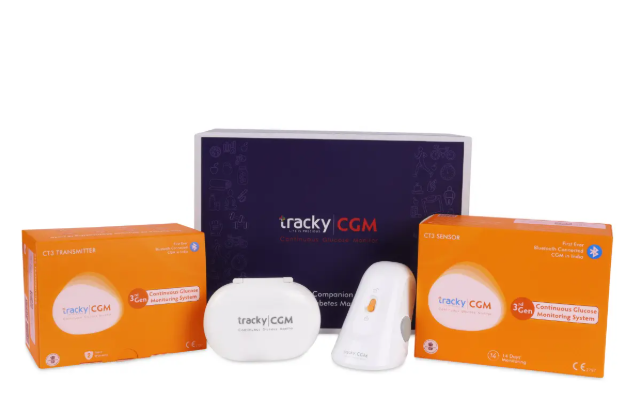Managing blood sugar levels effectively is the foundation of diabetes care. For decades, diabetics relied on traditional blood glucose test kits—tools that required finger pricking, strips, and manual record-keeping. While they provided essential insights into glucose levels, they came with limitations: infrequent readings, manual errors, and discomfort.
Today, technological innovation has revolutionized glucose monitoring through the development of CGM machines (Continuous Glucose Monitoring systems). These devices provide real-time, continuous insights into your body’s glucose fluctuations, empowering users to make data-driven decisions about diet, exercise, and medication.
This transformation is not just about convenience—it’s about improving health outcomes and enabling smarter diabetes management.
From Finger Pricks to Continuous Monitoring
The traditional blood glucose test kit works by collecting a drop of blood from the fingertip, placing it on a test strip, and inserting it into a meter to display glucose levels. While this method is effective, it only provides a single reading at a specific moment.
However, blood sugar levels fluctuate throughout the day based on food intake, stress, physical activity, and sleep patterns. A finger-prick test might miss significant highs and lows that occur between tests.
Enter the CGM tracker a small, wearable device that automatically measures glucose levels at regular intervals, typically every few minutes. Instead of pricking your finger multiple times a day, a tiny sensor under your skin continuously reads your glucose levels and sends data to your smartphone or smartwatch. This allows you to view real-time trends and receive alerts when your blood sugar goes too high or too low.
How a CGM Machine Works
A CGM machine consists of three main components:
- Sensor: A thin, flexible filament inserted just under the skin (usually on the abdomen or arm). It measures glucose in the interstitial fluid—the fluid between your cells.
- Transmitter: Attached to the sensor, it sends glucose readings wirelessly to your display device.
- Receiver or Mobile App: Displays real-time glucose readings, trends, and graphs.
Most CGMs measure glucose every 1 to 5 minutes, offering up to 288 readings per day. This constant stream of data gives a much clearer picture of how your glucose levels change throughout the day and night.
Benefits of Continuous Glucose Monitoring
Real-Time Awareness
One of the biggest advantages of a CGM tracker is the ability to see your glucose levels in real time. Instead of reacting to high or low readings after the fact, you can take immediate steps to correct them. For instance, you can adjust your meal choices, increase activity, or take medication before a dangerous spike or drop occurs.
Trend Analysis
Unlike standard test kits, CGM systems show glucose trends—whether your blood sugar is rising, falling, or staying stable. This trend data is invaluable for long-term management, as it helps you understand how certain foods, stress, or activities affect your levels.
Fewer Finger Pricks
While some CGM models still recommend occasional calibration, most modern devices have significantly reduced or even eliminated the need for routine finger pricks. This makes glucose monitoring much less invasive and more user-friendly.
Alerts and Predictive Warnings
Modern CGMs send instant notifications when your glucose levels are approaching dangerous thresholds. Some systems even predict where your blood sugar is headed, helping prevent hypoglycemia or hyperglycemia before it happens.
Improved Lifestyle and Confidence
Continuous feedback encourages users to make healthier lifestyle choices. When you see how your glucose reacts to a meal, you naturally begin to make better dietary decisions. Similarly, exercise routines can be fine-tuned to optimize blood sugar balance.
The Role of Smart Health Devices
The integration of CGMs with smartphones and smartwatches reflects a broader trend toward connected health technology. From fitness trackers to smart weighing scales, consumers are embracing devices that help them understand and improve their health through data.
By syncing with other smart devices, CGMs allow users to monitor not only their glucose but also related health metrics like heart rate, weight, and activity level. This interconnected approach paints a more complete picture of overall wellness—making disease management proactive rather than reactive.
Choosing the Right Glucose Monitoring Solution
Selecting the best device depends on your personal needs and lifestyle.
- For routine monitoring: A standard blood glucose test kit remains reliable and cost-effective for individuals who prefer manual testing.
- For advanced insights: A CGM machine offers continuous tracking, data analytics, and convenience—ideal for those looking for tighter glucose control.
Before switching to a CGM, it’s important to consult with a healthcare provider. They can help determine which model suits your condition, prescribe it if necessary, and ensure it integrates smoothly with your treatment plan.
The Future of Glucose Monitoring
As technology advances, we can expect CGMs to become smaller, more affordable, and even more accurate. Emerging models are exploring non-invasive glucose monitoring—meaning no skin insertion at all.
Moreover, artificial intelligence is being integrated to analyze CGM data and provide personalized recommendations in real time. Soon, diabetics may rely on predictive algorithms that help maintain optimal glucose levels automatically.
Final Thoughts
Blood sugar management is no longer about occasional checks—it’s about continuous awareness. Whether you use a blood glucose test kit for simplicity or a CGM tracker for detailed insights, the goal remains the same: achieving stable, healthy glucose levels.
By embracing modern tools like CGM machines, individuals gain control, confidence, and clarity in their diabetes journey. The future of health tracking is smarter, more connected, and undeniably transformative.

